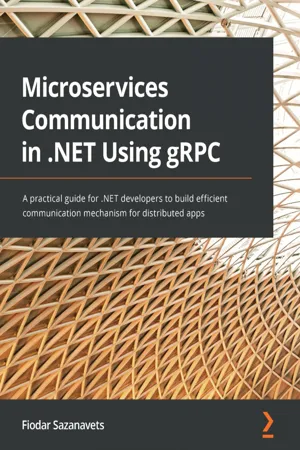
- 486 pages
- English
- ePUB (mobile friendly)
- Available on iOS & Android
Microservices Communication in .NET Using gRPC
About this book
Learn how to implement gRPC on the.NET platform step by step and cover how to use gRPC on.NET, including fundamentals, use cases, and best practices
Key Features
- Explore all aspects of gRPC implementation on.NET, from the most basic features to advanced ones
- Discover best practices for using gRPC to make sure that your applications are as efficient and as scalable as possible
- Identify when gRPC is the best tool for the job and when it isn't
Book Description
Explore gRPC's capabilities for faster communication between your microservices using the HTTP/2 protocol in this practical guide that shows you how to implement gRPC on the.NET platform.gRPC is one of the most efficient protocols for communication between microservices that is also relatively easy to implement. However, its official documentation is often fragmented and.NET developers might find it difficult to recognize the best way to map between C# data types and fields in gRPC messages. This book will address these concerns and much more. Starting with the fundamentals of gRPC, you'll discover how to use it inside.NET apps. You'll explore best practices for performance and focus on scaling a gRPC app. Once you're familiar with the inner workings of the different call types that gRPC supports, you'll advance to learning how to secure your gRPC endpoints by applying authentication and authorization.With detailed explanations, this gRPC.NET book will show you how the Protobuf protocol allows you to send messages efficiently by including only the necessary data. You'll never get confused again while translating between C# data types and the ones available in Protobuf.By the end of the book, you'll have gained practical gRPC knowledge and be able to use it in.NET apps to enable direct communication between microservices.
What you will learn
- Get to grips with the fundamentals of gRPC and Protobuf
- Debug gRPC components inside a.NET application to locate and fix errors
- Understand gRPC best practices, such as performance enhancement
- Effectively translate between gRPC and native C# code by applying well-known types
- Secure gRPC communication inside a.NET application
- Discover how to monitor gRPC on.NET by applying logging and metrics
Who this book is for
This book is for NET developers who are working with microservices and are looking for efficient solutions to facilitate communication between services using gRPC. Anyone who is familiar with microservices architecture and has knowledge of the fundamentals of.NET Core, but not necessarily of gRPC, will also find this book useful.
]]>
Frequently asked questions
- Essential is ideal for learners and professionals who enjoy exploring a wide range of subjects. Access the Essential Library with 800,000+ trusted titles and best-sellers across business, personal growth, and the humanities. Includes unlimited reading time and Standard Read Aloud voice.
- Complete: Perfect for advanced learners and researchers needing full, unrestricted access. Unlock 1.4M+ books across hundreds of subjects, including academic and specialized titles. The Complete Plan also includes advanced features like Premium Read Aloud and Research Assistant.
Please note we cannot support devices running on iOS 13 and Android 7 or earlier. Learn more about using the app.
Information
Table of contents
- Microservices Communication in .NET Using gRPC
- Contributors
- Preface
- Section 1: Basics of gRPC on .NET
- Chapter 1: Creating a Basic gRPC Application on ASP.NET Core
- Chapter 2: When gRPC Is the Best Tool and When It Isn't
- Chapter 3: Protobuf – the Communication Protocol of gRPC
- Section 2: Best Practices of Using gRPC
- Chapter 4: Performance Best Practices for Using gRPC on .NET
- Chapter 5: Applying Versioning to the gRPC API
- Chapter 6: Scaling a gRPC Application
- Section 3: In-Depth Look at gRPC on .NET
- Chapter 7: Using Different Call Types Supported by gRPC
- Chapter 8: Using Well-Known Types to Make Protobuf More Handy
- Chapter 9: Securing gRPC Endpoints in Your ASP.NET Core Application with SSL/TLS
- Chapter 10: Applying Authentication and Authorization to gRPC Endpoints
- Chapter 11: Using Logging, Metrics, and Debugging in gRPC on .NET
- Assessments
- Other Books You May Enjoy